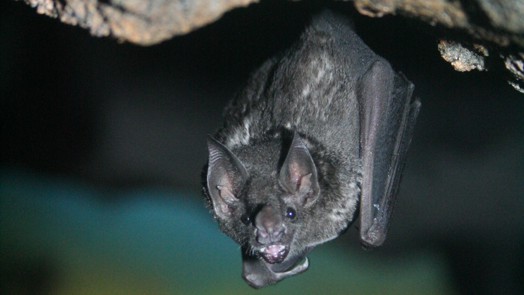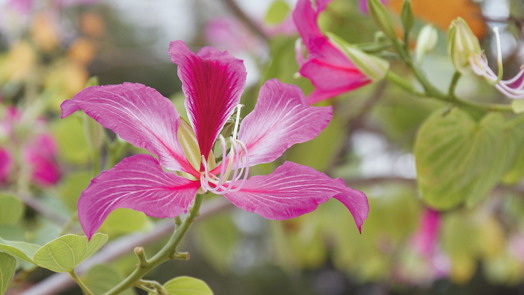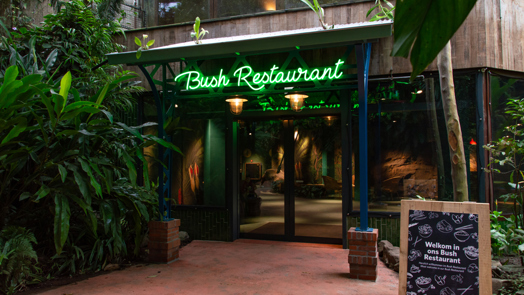
Burgers' Zoo is known for its eco-displays: nature reserves where animals often live in great freedom amidst thousands of plants, and visitors can experience such a habitat up close. An eco-display is designed to imitate a specific ecosystem as realistically as possible. What does that mean in practice? What are some of the characteristic features of an eco-display? What do biologists and designers need to consider when designing an eco-display? What challenges do they face? In this series, we focus on the essence of each eco-display through practical examples. This time: The Bush.
The Bush introduces us to the world of the tropical rainforest. As the name suggests, a tropical rainforest gets a lot of rain. The Bush has an ingenious watering system that sprinkles the habitat for several hours every night to imitate the rainfall. The sprinkling system partly uses collected rainwater. In the hot summer months, we store excess heat in our thermal storage system to be pumped back up again in the winter, so we use very little additional heating. The vegetation thrives in this warm and humid climate.

We prune the Bush all year round, but we usually prune larger quantities in the autumn. Recycling precious nutrients is essential in a tropical rainforest. The enormous variety of plant species and the amount of vegetation could lead you to assume that the soil in a tropical rainforest is rich in nutrients. However, the opposite is the case: the soil is very poor, and tropical rainforests are sometimes called 'deserts with trees'. The plants’ root systems immediately reabsorb all nutrients from decaying plant material that have been broken down by various bacteria, fungi and small animals, and use them for further plant growth.
Much of the pruned plant material is mulched and spread on the forest floor. This keeps the nutrients in the Bush in the system. The cycle is intact; we do not fertilise the plants. A small part of the fresh material is also used as animal feed for the leaf-eating monkeys or elephants, for example. There is a constant battle for sunlight in the tropical rainforest; some plants even establish themselves at the top of trees on branches of other plants. These plant species are called epiphytes.

Pruning is important for forestry reasons as well. We want to demonstrate the diversity of the different development stages of the tropical rainforest. As a result, trees can fall in the Bush, just like in the real rainforest. We use this to create open spaces in the forest, where the sunlight temporarily reaches the ground, giving plants on the ground a chance to reach maturity.
The Bush's tropical rainforest is a complex ecosystem where all species occupy a particular niche. Some smaller animals like fish, anoles, many insect species, and small frogs are actively hunted by various other species. Sometimes, a particular species of ant becomes too numerous. In many traditional animal enclosures, ant bait stations would be placed out of reach of the main inhabitants—problem solved. However, in an eco-display, you would be poisoning the bottom of the food chain with undesirable consequences! So, you have to find a biological solution, by introducing a natural enemy of that ant species, for example, but then there is a risk of the natural enemy becoming too numerous. In short, we are always carefully searching and adjusting to achieve a natural balance.
In addition to the various relationships between animal species, there are also important relationships between animal and plant species. Some plant species are entirely dependent on certain animal species—e.g., birds or bats—for pollination. In other examples, mammals or reptiles eat certain fruits and then defecate the seeds in another location.

Many external conditions influence the level of activity and behaviour of animal species. If you visit later in the afternoon, the fruit bats are more likely to be active, while other animals will be less visible. Normally, wrinkled hornbills mainly eat fruits. However, keep a pair of hornbills with young in the Bush, and the need for protein-rich food will temporarily increase. Despite supplementary feeding with protein-rich food, the birds will look for animal food, such as anoles, frogs or young birds. In this case, the biologists and zookeepers must assess whether the population of potential prey animals can cope with a pair of hornbills or whether it would unbalance the system.

Countless other examples illustrate the complexity and coherence of the Bush eco-display—there are so many that we could write a book on it! The aim, however, was to clarify this dynamic using a few practical examples. All these variable factors also mean that a visit to the Bush is never the same as a previous or future visit. The Bush never ceases to amaze and astonish, and you can discover something new every time.

Bats wrongly have a bad reputation. They are often said to be bloodthirsty vampires! If we look at t…
31 October 2022

The annual theme of the Association of Botanical Gardens (NVBT) is ‘Travelling Plants’. In this arti…
18 October 2022

On Wednesday, 12 October, the completely renovated Bush Restaurant will open its doors to all our vi…
14 October 2022